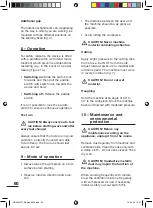
e
Do not use a chain or toothed saw
blade.
Such tools often cause kick
back or the loss of control of the elec-
trical tool.
Particular safety notes with regard to
sanding and abrasive cutting:
a
Use only grinding tools expressly
permitted for use with your electri
cal tool and the appropriate protec
tive hood for these grinding tools.
Grinding tools which are not designed
for use with the electrical tool cannot
be properly shielded and are unsafe.
b
The protective hood must be affixed
securely to the electrical tool and
set in such a way that it ensures the
maximum level of safety possible,
i.e. the smallest possible area of the
grinding tool is exposed to the oper
ator.
The protective hood should pro-
tect the operator from broken pieces
and accidental contact with the grind-
ing tool.
c
Grinding tools may only be used for
the recommended applications. For
example: Never sand using the side
surface of a cutting wheel.
Cutting
wheels are designed to remove mate-
rial with the edge of the disc. Lateral
forces working on these grinding tools
may break them.
d
Always use undamaged tension
ing flanges in the correct size and
shape for the sanding disc you have
selected.
Suitable flanges support
the sanding disc and thus reduce the
danger of the disc breaking. Flang-
es for cutting wheels may differ from
flanges for other sanding discs.
e
Do not use worn sanding discs
from larger electrical tools.
Sanding
discs for larger electrical tools are not
designed to handle the higher revolu-
tions of smaller tools and may break.
Additional safety notes with regard to
abrasive cutting:
a
Avoid blocking the cutting wheel or
employing too great a pressure. Do
not execute any excessively deep
cuts.
Overloading the cutting wheel
increases the wear and the tendency
to tilt or block and thus the possibility
of kick back or breaking of the grinding
tool.
b
Avoid the area in front and behind
the rotating cutting wheel.
If you
move the cutting wheel away from
you within the tool, in the event of
the electrical tool kicking back, the
turning wheel may be thrown in your
direction.
c
If the cutting wheel blocks or you
stop working, switch the unit off
and hold it still until the wheel has
come to a standstill. Never attempt
to pull a running cutting wheel out
of the cut, this may cause kick
back.
Work out and eliminate the
cause of the blockage.
d
Do not switch the electrical tool
back on with it still in the work
piece. Wait until the cutting wheel
has reached the full revolutions
before you carefully continue with
the cut.
Otherwise the wheel may get
caught, jump out of the workpiece or
cause kick back.
e
Support boards or large workpieces
to reduce the risk of kickback caused
by a jammed cutting wheel.
Large
workpieces may bend under their own
weight. The workpiece should be sup-
ported on both sides, both in the vicinity
of the cut and at the edge.
56
WU5405070_Bedien-2009.indd 56
WU5405070_Bedien-2009.indd 56
14.09.20 15:07
14.09.20 15:07
















































